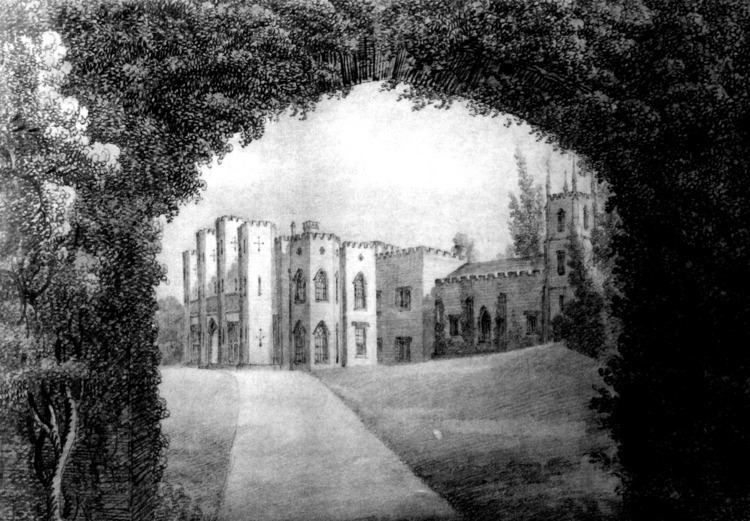 | ||
Yeotown was a historic estate situated in the parish of Goodleigh, North Devon, about 1 1/2 miles north-east of the historic centre of Barnstaple. The mansion house was remodelled in about 1807 in the neo-gothic style by Robert Newton Incledon (1761-1846), eldest son of Benjamin Incledon (1730-1796) of Pilton House, Pilton, near Barnstaple, an antiquarian and genealogist and Recorder of the Borough of Barnstaple (1758–1796). It was demolished during his lifetime and today only one of the large gatehouse survives, since converted into a farmhouse known as Ivy Lodge. The surviving drawing of the house in the collection of the North Devon Athaneum in Barnstaple shows a large chapel, or small church, with a tall square three-storied pinnacled tower (presumably as is conventional at the west end) attached to the house.
Contents
Location
The mansion house was situated in the sequestered wooded valley of the small River Yeo, about 1 mile south-west of the village of Goodleigh. Near to what Gribble (1830) called "Yeotown Lodge" (now Ivy Lodge) on the road from Goodleigh to Barnstaple is situated the stone marker of the eastern boundary of the parish of Barnstaple.
History
The earliest recorded owners of the estate were the Beavis family
Beavis
Incledon
Robert Newton Incledon (1761-1846), eldest son of Benjamin Incledon (1730-1796) of Pilton House, Pilton, near Barnstaple, an antiquarian and genealogist and Recorder of the Borough of Barnstaple (1758–1796). In 1797 married Elizabeth Beavis (d.1809), the adopted daughter of Col. Henry Beavis of Yeotown. In 1806 Robert sold Pilton House to James Whyte and in 1807 was resident at Yeotown House, the mansion house on his wife's family estate of Yeotown, which he "new fronted in the Gothic style" to his own design. Robert purchased from the Rashleigh family the manor of Goodleigh, and thus Yeotown became the manor house of Goodleigh. For reason unknown the mansion was demolished during the lifetime of Robert Newton Incledon (d.1845), who died aged 84 at his residence in Ilfracombe. The large ledger stone of Robert and his wife Elizabeth Beavis survives in the south aisle of the chancel of Pilton Church, inscribed as follows:
He left two daughters, including Margaret Incledon, the last of the Incledon family, alive in 1890, jointly lords of the manor of Goodleigh in 1850.
Abandonment & demolition
The historian of Barnstaple Joseph Gribble wrote in 1830 concerning the River Yeo: "This stream...forms one of the most prominent objects of attraction from the late splendid but now desolate and forsaken mansion of Yeotown".
Today there survives only one of the large imposing castellated gate house lodges, with two square towers either side of the tall gothic arched entrance way, to which was later added a farmhouse with crenellated gable-end to match with bay-window. It is now a grade II listed building known as Ivy Lodge.
